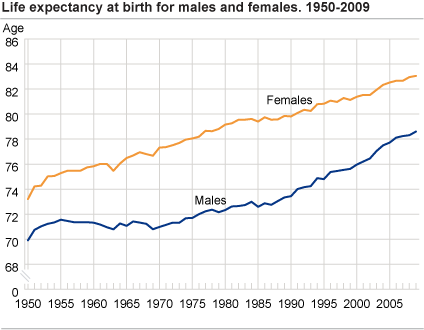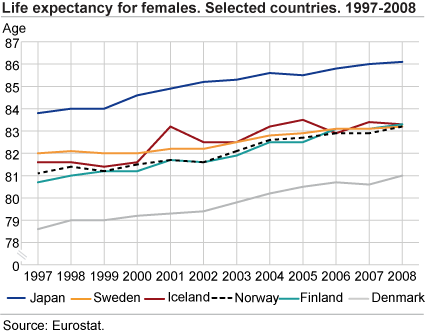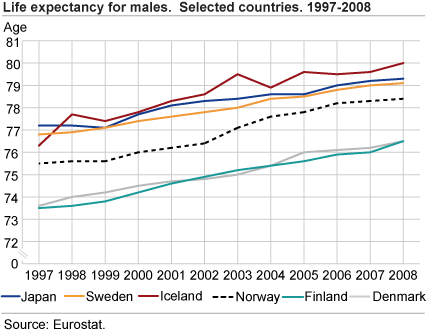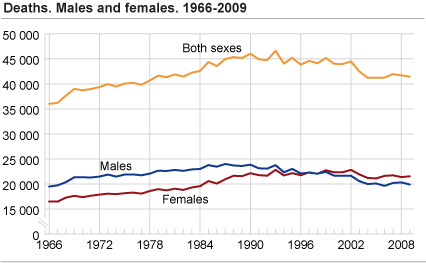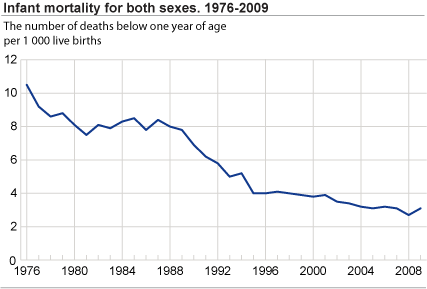Content
Published:
This is an archived release.
We still live longer
From 2008 to 2009, life expectancy at birth increased by 0.1 years for women and 0.3 years for men, to 83.1 years for women and 78.6 for men. This is the highest life expectancy registered in Norway ever.
The life expectancy has steadily increased during the last 200 years by about 0.2 years every year. For men, particularly, there has been a significant increase in the last 20 years. However, the increase was low in 2007 and 2008, but increased again in 2009.
Japanese women and Icelandic men live longest
Norway is among the 8 to 10 countries in the world with the highest life expectancy at birth. Norwegian women can expect to live almost as long as other women in the Nordic countries, but still shorter than women in Japan, who had a life expectancy of 86.1 years in 2008. Men in Norway live about 2 years less than men in Denmark and Finland, but a little bit longer than Swedish and Icelandic men. Icelandic men have the highest life expectancy in the world with 80.0 years in 2008.
The gap between the sexes decreases
The gap in life expectancy between the sexes has continuously been decreasing in recent decades, from 6.9 years in 1986 to 4.5 years in 2009. In the 1950s, the gap between men and women was considerably higher than today, but it has been steadily narrowed and has now decreased to 3-4 years.
The number of deaths and the death rate are low
In 2009, 41 400 persons died; 21 500 women and 19 900 men. This is a decrease of 250 deaths compared to last year. In the last five years the number of deaths has been between 41 200 and 42 000. The number of deaths is influenced by the population growth, age cohorts and life expectancy and we must go back to the 1970s to find a lower number of deaths. Since the end of the 1990s there has been an increasing majority of women dying, due to the fact that there are now more women in the age groups when people usually die. The summary death rate, i.e. the number of deaths per 1 000 of the mean population, has never been lower. In 2009 it was 8.6 for both sexes, 8.3 for men and 8.9 for women. In the 1970s the death rate was about 10 for both sexes, 11 for men and 9 for women.
Low infant mortality
The infant mortality for both sexes was 3.1 in 2009, which is an increase of 0.4 from 2008. The infant mortality in 2008 was the lowest ever registered in Norway. In 2009, 192 children below 1 year of age died; 119 boys and 73 girls. The infant mortality rate for boys was 3.7 per 1 000 live births, and the corresponding figure for girls was 2.4. There might however be some coincidences from the one year to another.
Tables:
- Table 1 Deaths and death rates 1961-2009
- Table 2 Age-specific death rates for males and females. 1971-2009
- Table 3 Life expectancy - remaining years for males and females at selected ages. 1866-2009
- Table 4 Perinatal and infant mortality. 1956-2009
- Table 5 Life tables. 2009
- Table 6 Life expectancy - remaining years for males and females at selected ages, by county. 1971-2005
Contact
-
Anders Sønstebø
E-mail: anders.sonstebo@ssb.no
tel.: (+47) 46 66 37 74
-
Magnus Haug
E-mail: magnus.haug@ssb.no
tel.: (+47) 40 81 14 91
-
Ane Margrete Tømmerås
E-mail: ane.tommeras@ssb.no
tel.: (+47) 91 99 29 62
-
Statistics Norway's Information Centre
E-mail: informasjon@ssb.no
tel.: (+47) 21 09 46 42
-
Oppdrag befolkningsstatistikk
E-mail: befolkning@ssb.no

